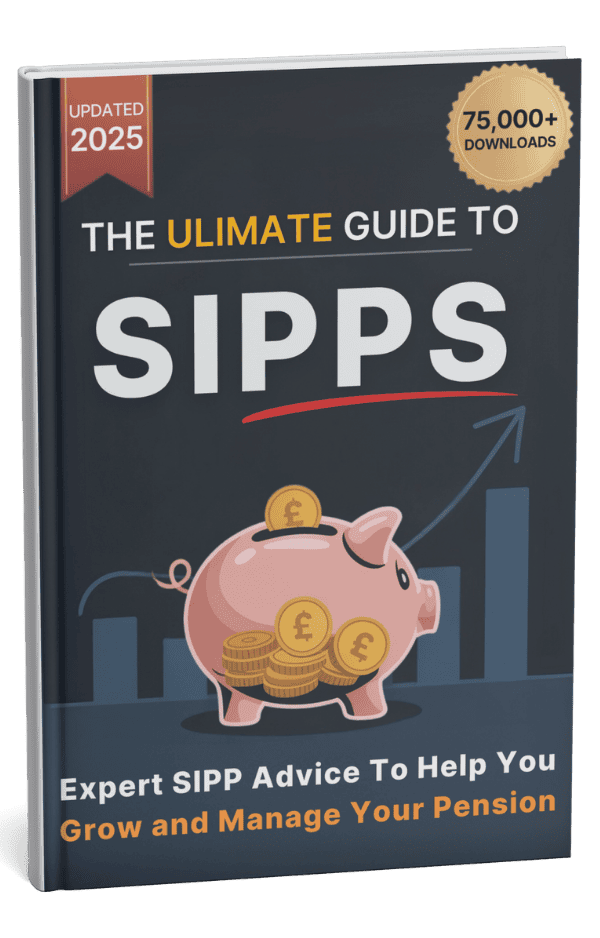
How Can You Make the Most of Your SIPP Investments?
See How Much Your Future Pension Income Could Be In Just 60 Seconds — No Fees, No Obligation.
How Much Could You Unlock?
Why Homeowners Trust Us
Try Our Free Pension Calculator
Quick, Safe Estimate

No Commitments
Key Takeaways
- SIPPs offer flexibility in how you manage your retirement funds.
- Anyone eligible for a personal pension can open a SIPP—ideal for experienced investors.
- You can invest in a wide range of assets, including shares, funds, ETFs, and commercial property.
- Tax relief on contributions up to £60,000 per year (or 100% of your income) in 2025 remains a key advantage.
- Reviewing your SIPP strategy regularly helps ensure it aligns with your long-term retirement goals.
- SIPPs may involve higher charges and require active management, making them best suited to informed investors.
If you’ve ever asked yourself, “What’s a SIPP?”, you’re in the right place to explore this popular pension option, especially considering that understanding SIPPs is key to confidently navigating your retirement planning.
A Self-Invested Personal Pension (SIPP) offers a flexible, tax-efficient way to save for your golden years, and while the road to a secure retirement can seem overwhelming, choosing the right investment vehicle can make all the difference.
In this guide, we’ll break down the benefits, risks, and how SIPPs differ from regular pensions—helping you maximise your 2025 investment strategy.
Ready to dive in? Let’s get started...
What Are SIPPs Pensions? Understanding the Basics of Self-Invested Personal Pensions
A SIPP (Self-Invested Personal Pension) gives UK investors more control, flexibility, and tax efficiency over how they save and invest for retirement. With contribution caps increased and the Lifetime Allowance abolished in 2023, SIPPs are now more powerful than ever.
Offering everything from ETFs and shares to commercial property and ESG funds, SIPPs are perfect for those looking to escape the restrictions of conventional pensions. But with greater control comes greater responsibility—understanding how SIPPs work in 2025 is essential for long-term success.
Ready to take ownership of your retirement? You can explore all the essentials with our updated SIPP requirements checklist.

In summary
A SIPP offers control and flexibility over your retirement savings, allowing you to align your pension investments with your personal financial goals; however, it's essential to note the risks associated with investments, as values can go down as well as up.
A SIPP also operates as a 'pension wrapper,' which means it benefits from tax relief on contributions, tax-free investment growth, and the flexibility to withdraw 25% of the fund as a tax-free lump sum at retirement.
SIPP Pension Plan: Why It Matters
A SIPP pension plan works similarly to other pensions in that it allows you to save for retirement and receive tax relief on your contributions; however, the key difference lies in the investment choices and control.
By managing investments directly, SIPP holders can potentially enhance their returns compared to traditional pension plans, though it does come with added responsibility and risk.
Who Can Benefit from a Self-Invested Personal Pension (SIPP)?
SIPPs are designed for individuals who want more control over their retirement savings and investment choices, particularly proving ideal for those with investment experience or who want a wider range of investment options than standard pension plans typically offer.
It's important to note that SIPPs may not suit everyone, so it’s best to seek professional financial advice to determine if a SIPP is appropriate for your specific circumstances.
How Do SIPPs Work in 2025? Contribution Limits, Tax Relief, and Investment Options
SIPPs operate as a personal pension “wrapper” that allows investors to choose how and where their pension savings are invested. Contributions are eligible for government tax relief, and investments grow free of capital gains or income tax.
Upon retirement (as early as age 55, rising to 57 in 2028), you can withdraw:
- 25% of your pot tax-free
- The rest as income, subject to tax bands
This freedom makes SIPPs ideal for tailored retirement strategies, income phased withdrawals, and estate planning.
For those wondering “is a SIPP a good idea for me?”, our comparison of the best SIPPs in 2025 is a smart place to begin.
SIPP vs Personal Pension: What’s the Difference and Which Should You Choose?
A SIPP differs from a regular pension in that it offers greater flexibility and control over investments; individuals can choose from a wider range of assets, while regular pensions often have limited investment options managed by the provider.

Here’s a quick look at the main differences:
- Investment Control: SIPPs allow you to actively manage your pension investments, whereas regular pensions are typically managed passively by the provider.
- Investment Range: SIPPs provide access to a broader range of assets, while traditional pensions are usually more limited in their options.
- Access Flexibility: SIPPs offer more tailored ways to access your retirement income, whereas regular pensions follow more structured approaches.
SIPPs do typically require a more hands-on approach and higher risk management, and you can only access your SIPP at the minimum pension age of 55, rising to 57 by 2028.3
The longer you leave your SIPP untouched, the more time your pension pot has to grow.
Please note: All assumptions in this article are based on current laws and regulations, which are subject to change and may affect SIPPs’ benefits and limitations
Are SIPPs a Good Idea in 2025? Key Features, Risks, and Investment Flexibility
Key Benefits of Using a SIPP for Retirement
SIPPs go beyond traditional pensions—offering both tactical and long-term benefits. Here’s a closer look:
1. Investment Control and Customisation
With a SIPP, you aren’t locked into a pre-selected fund. You can invest in:
- UK and global stocks
- Index funds and ETFs
- Government and corporate bonds
- Commercial property
- Thematic or ESG funds
Explore providers like Fidelity or Nutmeg to see how SIPP platforms vary in choice and accessibility.
2. Boosted Tax Relief on Contributions
In 2025, the annual allowance sits at £60,000. You can receive tax relief up to:
- 20% for basic-rate taxpayers
- 40% for higher-rate
- 45% for additional-rate
These top-ups significantly enhance the compound growth potential of your fund.
3. Estate Planning Potential
SIPP funds can pass to beneficiaries outside your estate, potentially avoiding Inheritance Tax. For a detailed breakdown of protecting your legacy, read our guide on Inheritance Protection for SIPPs and Equity Release.
Understand the Drawbacks: What Are the SIPP Risks?
SIPPs aren't suitable for everyone—especially passive savers or those who prefer simpler pension planning.
1. Investment Risk and Market Volatility
Unlike a stakeholder pension, you’re responsible for choosing assets. Losses can happen if investments underperform or fluctuate sharply.
2. Complex Decision-Making
SIPPs require attention; without a sound strategy or adviser, investors may struggle with diversification or over-concentration.
3. Potentially Higher Costs
Some SIPP platforms charge:
- Platform fees
- Fund transaction costs
- Property management or admin charges
It’s wise to refer to our Equity Release & SIPP Costs Checklist to benchmark what’s competitive in 2025.t’s advisable to consult with a financial adviser to develop a robust investment strategy and mitigate potential downsides when managing a SIPP.
SIPP Government Top Up: How Tax Relief Works
One of the main benefits of a SIPP is the government top-up in the form of tax relief; for every contribution you make, the government adds tax relief based on your income tax rate.
For basic-rate taxpayers, this means a 20% top-up on contributions, effectively boosting your retirement savings.
Higher-rate taxpayers can claim additional relief through their self-assessment tax return, making SIPPs a tax-efficient way to save and enhance the value of your contributions.
What Is The Future of SIPPs? Trends, Regulation Changes, and Strategic Planning
The future of SIPPs appears optimistic, especially following the UK government's recent pension reforms.
In March 2023, the Lifetime Allowance (LTA) of £1,073,100 was abolished; previously, pension contributions exceeding this threshold were taxed up to 55%.7 With the LTA scrapped, individuals can now contribute more to their pension without tax penalties.8
Additionally, the annual allowance for pension contributions has increased from £40,000 to £60,000, enabling workers to invest £20,000 more annually into their pensions while still enjoying tax relief.9
However
It's important to remember that depending on how and when you access your pension, Income Tax could still be applied to sums beyond the previous LTA.
As SIPPs grow in popularity, these changes make them even more attractive for those looking to maximise their retirement savings, so to navigate the full implications of these reforms and ensure tax efficiency, it’s advisable to consult with your financial adviser.

Step-by-Step Roadmap — How to Open a SIPP in 2025
Opening a SIPP may seem overwhelming, but the process is straightforward when broken down into these simple steps:
Step 1 – Choose a FCA Regulated Provider
Select a trusted SIPP provider that aligns with your investment preferences, fee tolerance, and advisory needs. Check our best plan checklist to assess your options.
Step 2 – Verify Eligibility and ID
You’ll need a National Insurance number, proof of UK residency, and valid photo ID. This identification process ensures regulatory compliance.
Step 3 – Transfer In or Make Contributions
You can contribute via lump sum, regular deposits, or transfer old pensions (beware of exit penalties). Make sure your total contributions don’t exceed the annual allowance.
Step 4 – Start Investing
Use your platform dashboard to manage investments, monitor growth, and rebalance periodically based on your retirement horizon.
The Rise of Thematic and ESG Investing in SIPPs
In 2025, more savers are aligning their pensions with personal values. Thematic investments—focusing on green energy, AI, healthcare, or emerging markets—are gaining traction in SIPP portfolios.
Why this matters:
- ESG and thematic portfolios are diversified yet target high-growth industries.
- Many platforms offer pre-built sustainable funds for convenience.
- Conscious capitalism is in: more investors want returns with purpose.
Want to plan ethically? Browse our guide to ethical and socially responsible SIPPs.
Common Questions
A SIPP can benefit your retirement planning in several ways. Firstly, it offers tax advantages, allowing you to receive tax relief on your contributions. This means that for every £1 you contribute, the government adds an additional amount based on your tax rate.
Secondly, a SIPP provides flexibility in terms of investment choices, allowing you to tailor your pension portfolio to suit your risk appetite and financial goals.
Lastly, a SIPP provides the potential for higher returns compared to traditional pension schemes, as it allows you to take advantage of investment opportunities in the market. A SIPP offers multiple benefits for retirement planning. It provides tax advantages by offering tax relief on contributions, meaning more money goes into your pension pot. The flexibility of investment options allows you to align your pension portfolio with your risk tolerance and financial objectives.
Additionally, a SIPP provides the potential for higher returns compared to other pension schemes, as you have the freedom to invest in a wide range of assets. By utilizing these benefits, you can better plan for a financially secure retirement.
Learn More: Full SIPPs
There are several tax benefits associated with a SIPP. Firstly, you receive tax relief on your contributions, meaning that for every £1 you contribute, the government adds tax relief based on your tax rate.
Secondly, any growth or income generated within the SIPP is tax-free, allowing your investments to grow more efficiently.
Lastly, when it comes time to retire, you are entitled to take up to 25% of your SIPP as a tax-free lump sum, offering financial flexibility in your retirement.
A SIPP offers various tax benefits for retirement planning. Contributions are eligible for tax relief, with the government adding an additional amount based on your tax rate. Any growth or income within the SIPP is tax-free, allowing your investments to compound more effectively.
Furthermore, upon retirement, you can withdraw up to 25% of your SIPP as a tax-free lump sum, providing financial flexibility. These tax advantages make a SIPP an attractive option for individuals looking to optimize their retirement savings.
With a SIPP, you have a wide range of investment options to choose from.
These can include stocks and shares, investment funds, government bonds, corporate bonds, commercial property, and more. The specific investments available to you may depend on the SIPP provider you choose and the level of risk you are willing to take.
It’s important to carefully consider your investment choices and seek professional advice if needed to ensure they align with your financial goals and risk tolerance.
There’s no minimum age to open a SIPP, as long as you’re under 75.15
However, you’ll need to be at least 18 years old to establish a SIPP and start contributing towards your pension savings yourself, while a Junior SIPP’s designed specifically for children and young people under the age of 18.
This type of SIPP allows parents, guardians, or grandparents to save for a child’s future retirement by making contributions into a pension pot on the child’s behalf.
How much you can contribute to a SIPP annually before paying tax on your contributions is governed by HMRC’s annual allowance, which is £60,000 for the current tax year.16
It’s important to note that the annual allowance applies to all your private pension products, including your SIPP.
If you do not fully use your annual allowance in the current tax year, you may have the option to carry over any unused allowance from the previous three tax years.17
This means you can potentially contribute more than the annual allowance in a specific year by utilising any unused allowance from the previous years, subject to certain conditions and rules.
Yes, you can transfer an existing pension, including workplace pensions or other personal pensions, into a SIPP.18
Consolidating your pension pots into a single SIPP can simplify the management of pension investments and potentially provide access to a broader range of investment options.19
However, you’ll need to consider the impact of fees or the loss of benefits when transferring from an existing scheme.
Seeking professional financial advice is recommended to understand the specific circumstances and implications of pension transfers.
What happens to your SIPP when you pass away will depend on several factors.
If you haven’t yet started accessing your pension savings, the value of your SIPP can be passed on to your beneficiaries.
The pension can be inherited by your spouse or civil partner, usually tax free, and they may have the option to continue the pension or take a lump sum or regular income from it.
If you pass away after the age of 75, the inherited pension may be subject to income tax when withdrawn by your beneficiaries.20
If you’ve already started accessing your pension, the treatment of your SIPP upon death will depend on the specific circumstances and choices you have made.
For example, if you’ve purchased an annuity or opted for a drawdown arrangement, the terms of those arrangements will determine what happens to the remaining funds upon your death.
It’s advisable to review the pension provider’s terms and seek professional advice to understand the options for and implications of passing on your SIPP.
A SIPP pays out via different options depending on your choices and circumstances.
When you reach retirement age, you can typically access your SIPP in the form of a regular income (annuity) or as a 25% tax-free lump sum withdrawal.21
Alternatively, you can choose to keep your funds invested within the SIPP and opt for drawdown arrangements, which allow you to take flexible withdrawals while the remaining funds remain invested.22
The specific payout options and tax implications will depend on the rules and regulations in place at the time of retirement.
How you know if a SIPP’s right for you depends on whether you’re after greater control and flexibility over your pension investments and are willing to make investment decisions or seek professional advice.
Consider the following questions:
- Do you have a good understanding of investments and the risks involved?
- Are you comfortable taking responsibility for managing your own pension investments?
- Do you want a wider range of investment options than those offered by regular pension schemes?
- Are you prepared to spend time monitoring and managing your pension investments?
- Are you willing to accept the potential investment losses and volatility that come with a wider range of investment options?
If you answer positively to these questions and have the financial means to make contributions to a SIPP, this product may be worth considering.
Speak to a financial or pensions advisor to discuss your options in detail.
In Conclusion
A SIPP can be a powerful tool to align your retirement planning with your financial goals.
Self-invested personal pensions go beyond simple saving—they empower you to actively invest and make informed decisions about your future. With tax advantages, flexibility, and diverse investment choices, a SIPP can reshape how you approach retirement.
So, as you explore your options and ask, “What is a SIPP?”, remember it’s not just a pension—it’s a vehicle that could help you take control of your financial future.
Want to get to grips with the terminology in this article? Visit our SIPPs Glossary — a simple, no-nonsense guide to all the essential terms, helping you navigate self-invested personal pensions with confidence.

Found an Error? Please report it here.






 100% private. No pressure. Just friendly guidance.
100% private. No pressure. Just friendly guidance.


